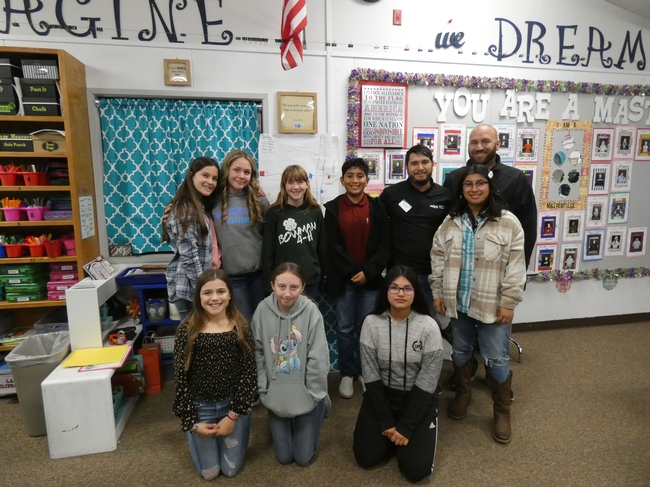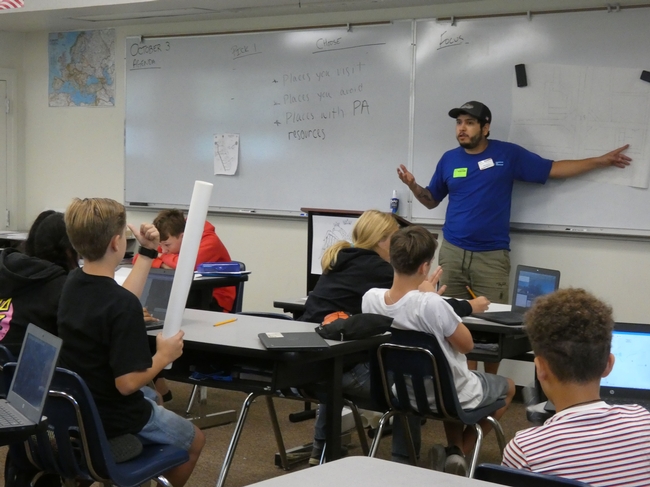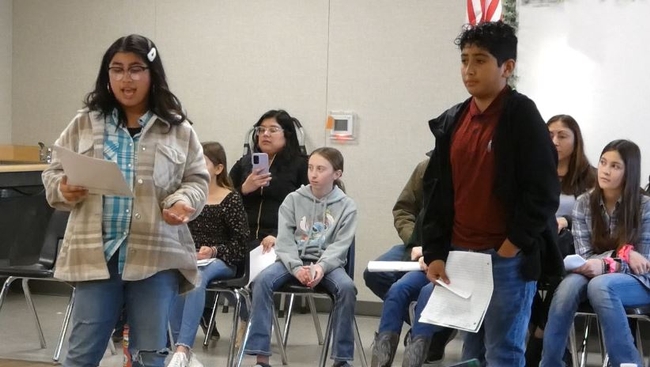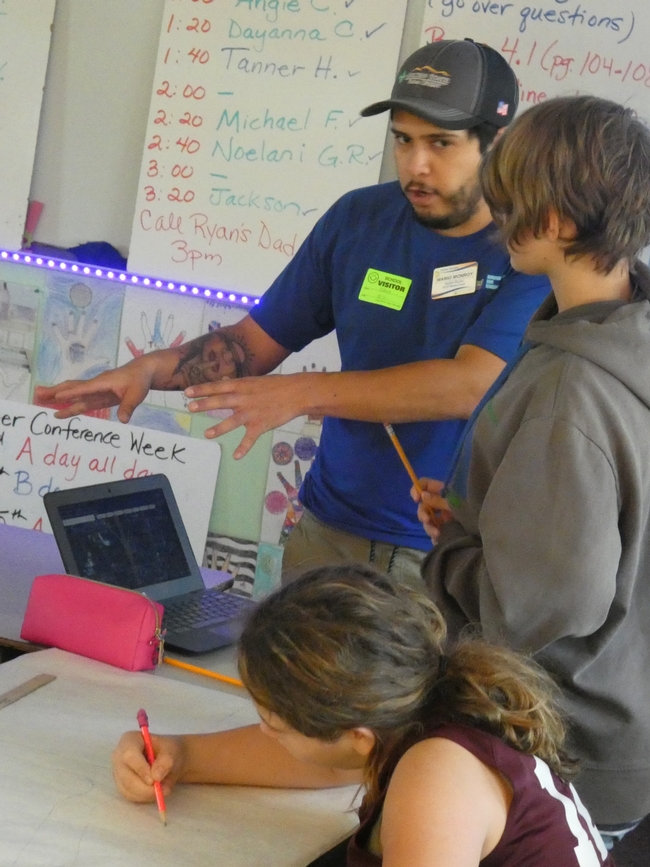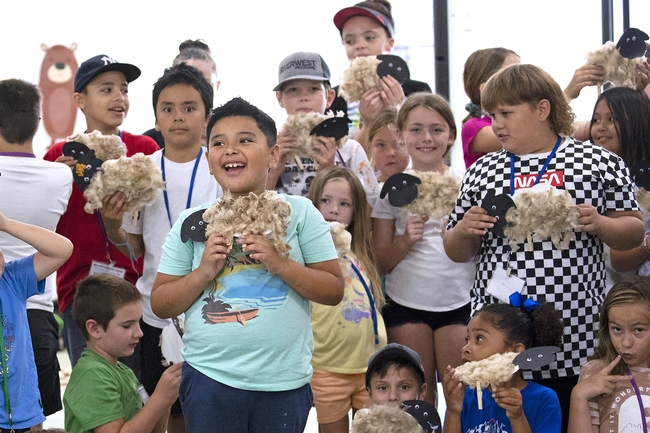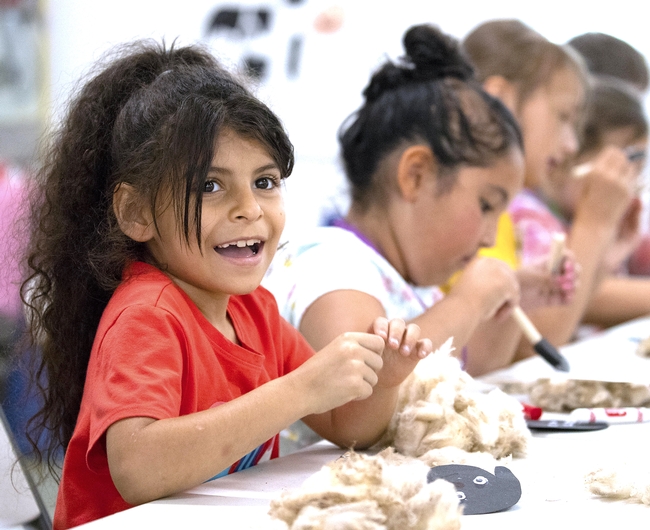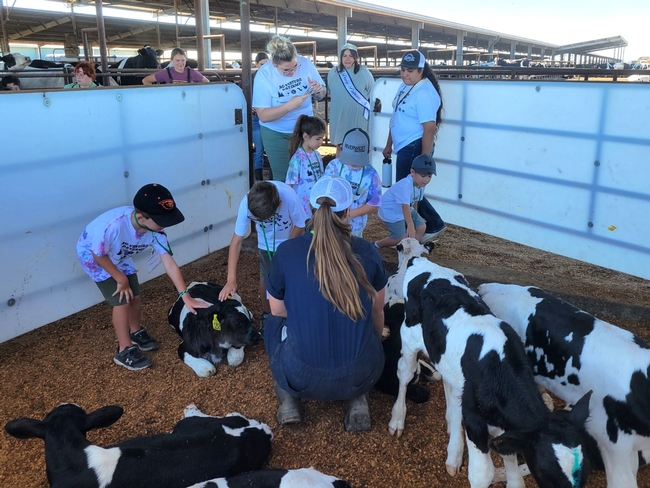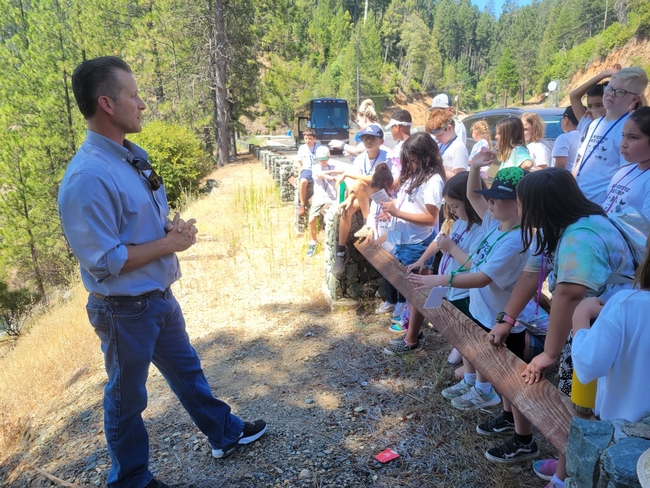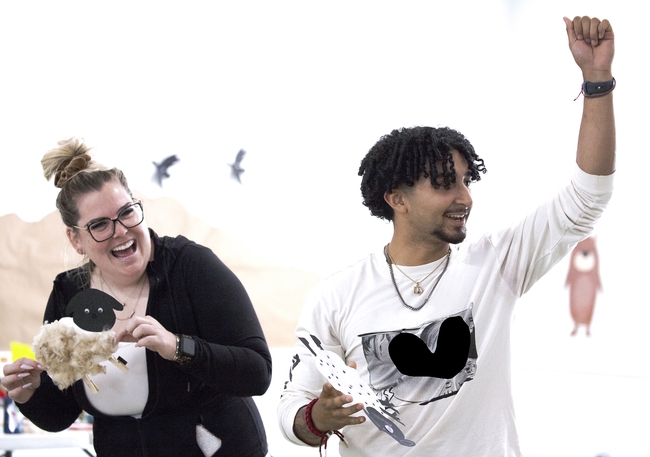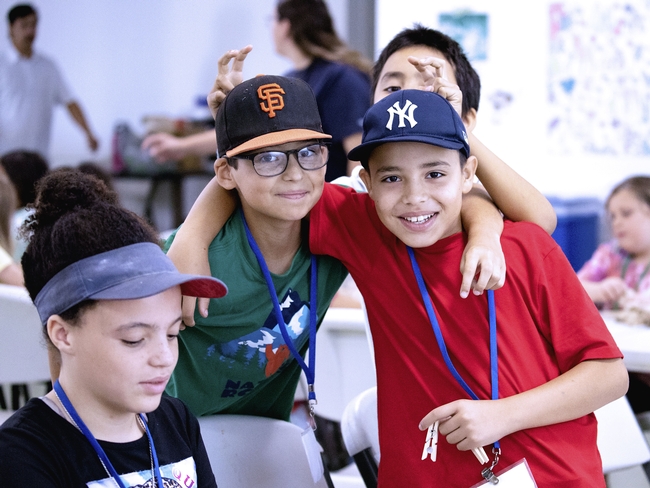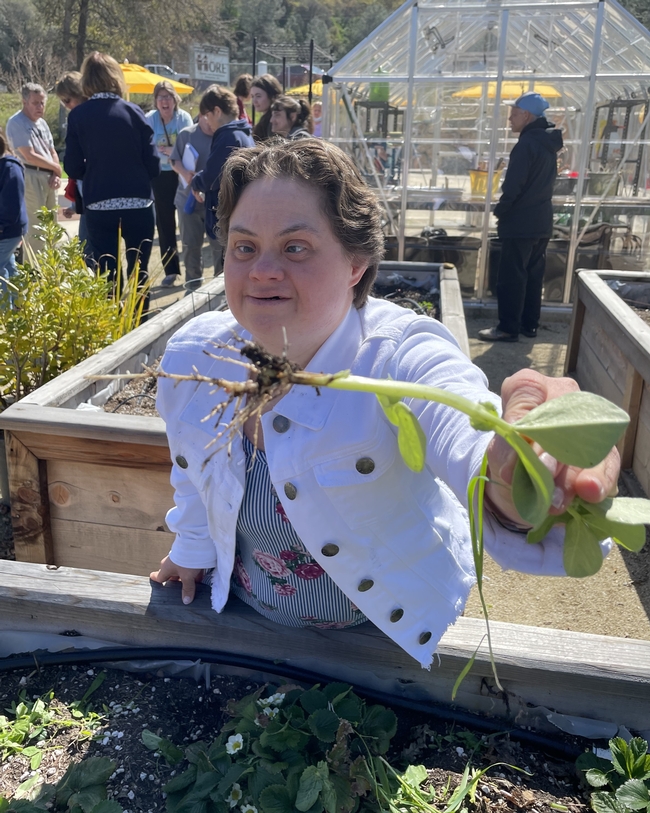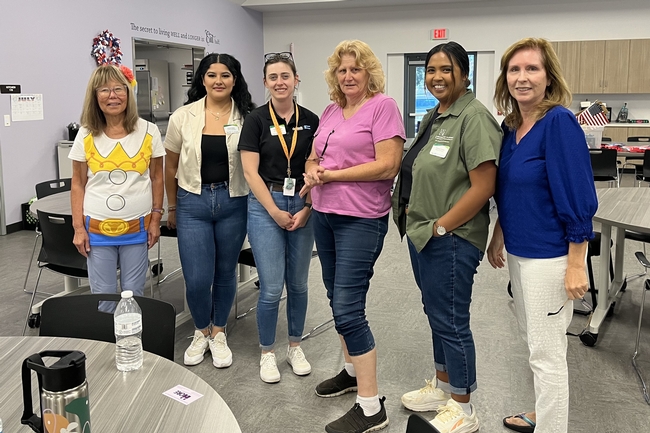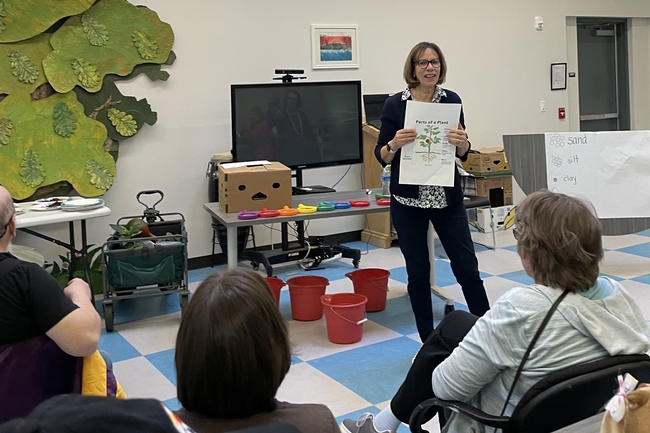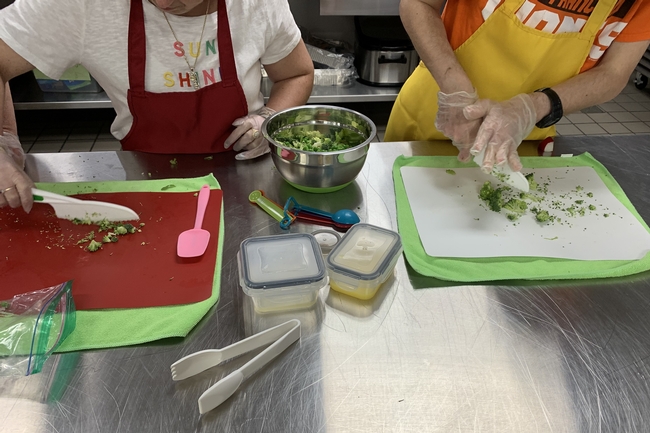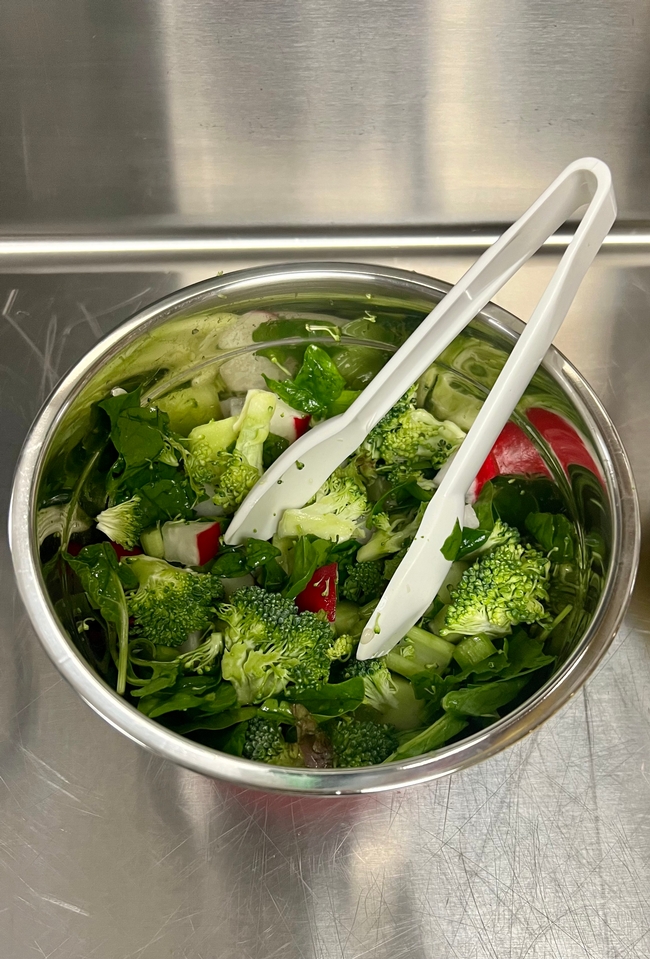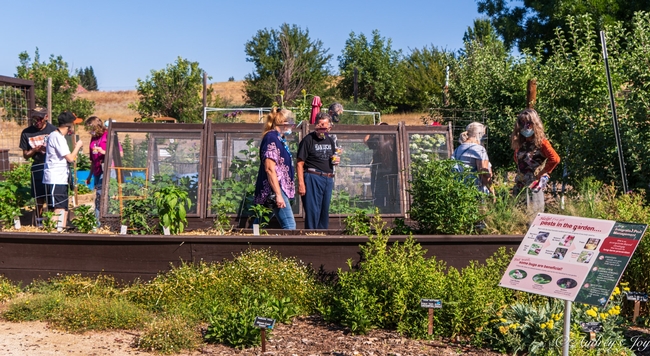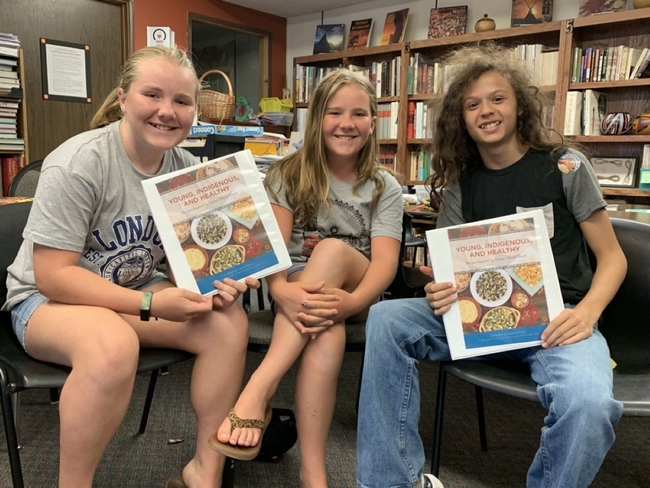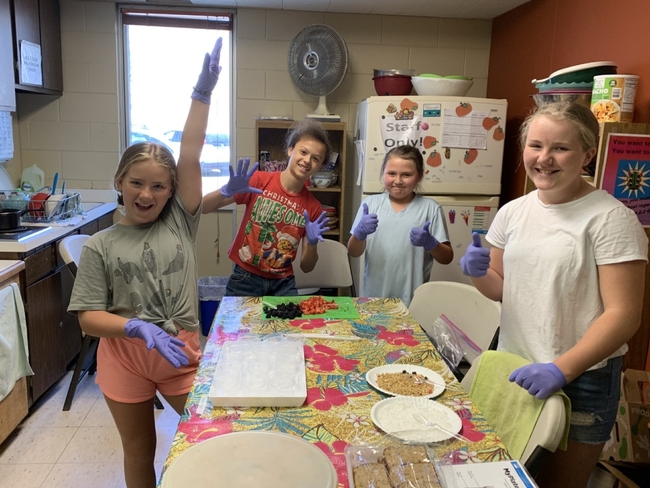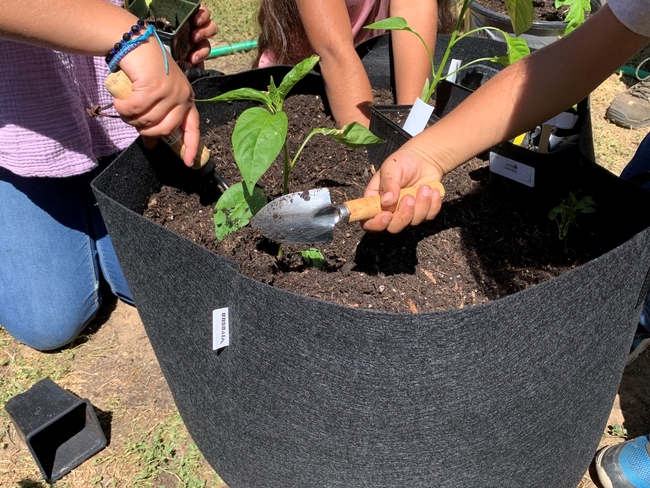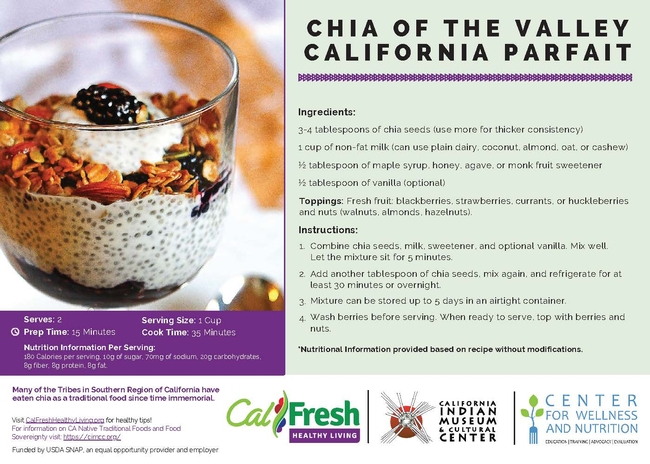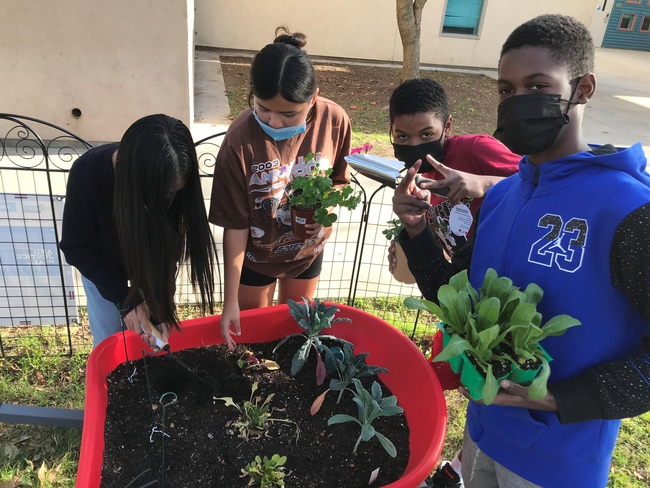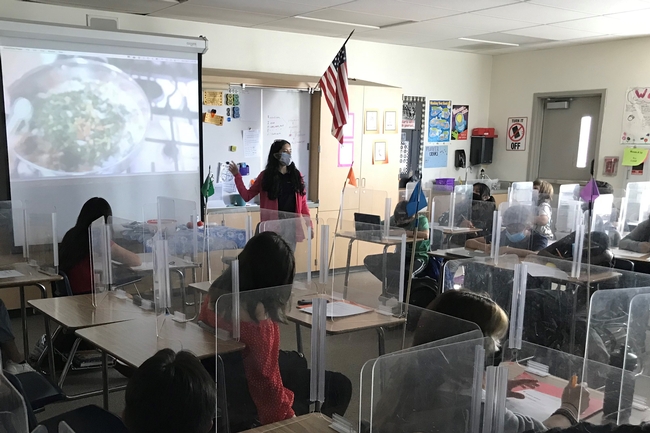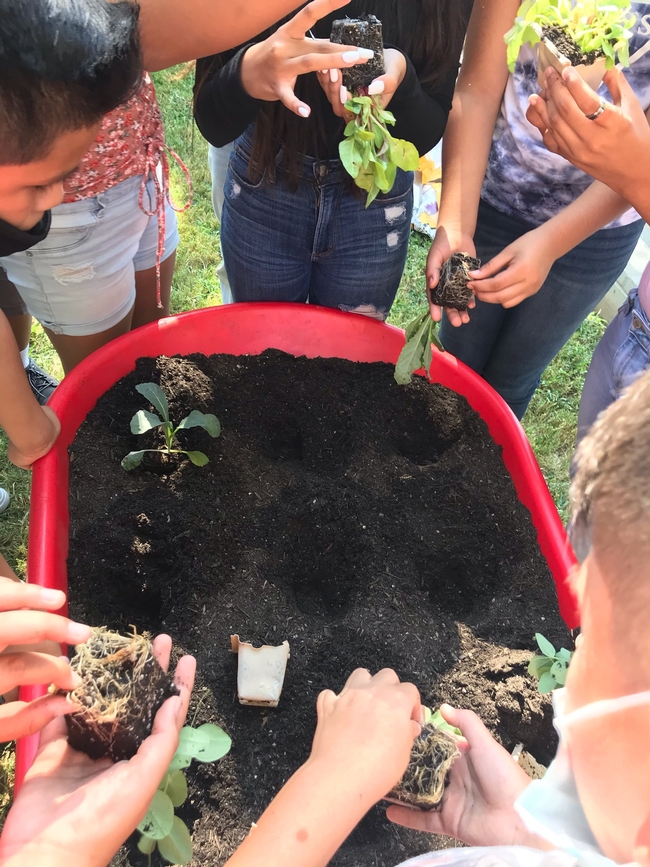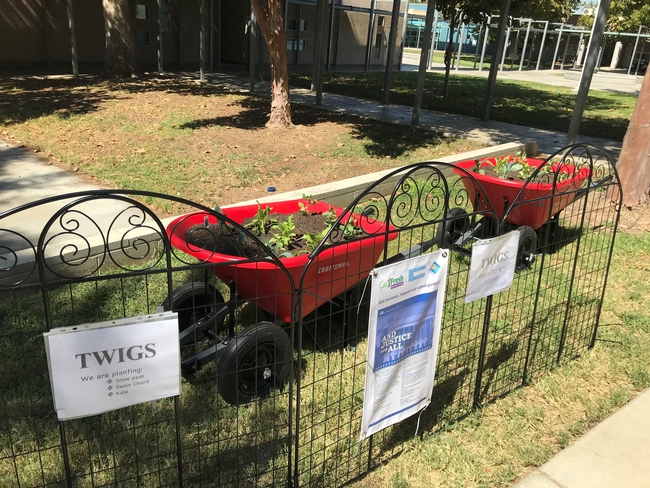Posts Tagged: CalFresh Healthy Living
Sixth graders advocate for physical activity upgrades at school
Tehama County students empowered by CalFresh Healthy Living, UCCE educator and teachers
It's not uncommon for high school or college students to speak up and seek to improve their school environment. But at Evergreen Middle School in Tehama County, more than 100 sixth graders led the way to create healthy changes at their school.
As part of their health classes during the 2022-23 school year, the students researched the availability of spaces for physical activity, developed a survey gauging their peers' health awareness and needs, analyzed the results and data, and made recommendations for improvements.
“We learned that there's not a lot of places – except for Evergreen Middle School and some other parks around [our community of] Cottonwood – that have many physical activity places that you can easily get to or have access to,” said Bailey, one of the students.
They were guided by Mario Monroy-Olivas, a nutrition educator with CalFresh Healthy Living, University of California Cooperative Extension in Tehama, Shasta and Trinity counties. Locally administered by UC Agriculture and Natural Resources, CFHL, UCCE is one of the agencies in California that teaches nutrition to people eligible for SNAP (Supplemental Nutrition Assistance Program) – referred to as CalFresh Food in California.
Working alongside Evergreen teachers Roxanne Akers and Albert Estrada, Monroy-Olivas challenged the sixth graders to tackle a “Youth Participatory Action Research” project – a yearlong, multi-step undertaking typically designed for older teens.
“The fact that we're doing it with these younger kids, starting a lot sooner, I think it's super impactful for them to know that, together, collectively they can make huge changes that will create positive outcomes – not just for themselves but for an entire community,” Monroy-Olivas said.
Middle school students speak up at school board meeting
In February 2023, eight class representatives presented their findings to the Evergreen Union School District Board of Education. Speaking before the five-member board for 20 minutes, the young people were naturally a bit nervous.
“It was a little nerve-wracking at first, but it wasn't that bad, once we got up there and got it over with,” said Lilah, one of the presenters. “Me and a couple of my friends were doing pep talks and practicing what we were going to say.”
The students showed a composite map that they drew from their classes' investigation of spaces for physical activity in the area, and shared a brochure that outlined their research and survey results. In a survey of more than 80 of their peers, 92% of respondents said they needed more access to physical activity equipment during class breaks, recess and lunch.
“The board members were super impressed with the students, coming to the school board and doing this,” Monroy-Olivas said. “They said they haven't had students doing this kind of advocacy work; for them, it was a really big deal.”
In the end, the young people made a strong case for more water-bottle refilling stations, badminton equipment and balls for other sports, and stencils for schoolyard activities like hopscotch, four square and snail (a type of hopscotch game).
“We got almost everything we asked for, and the project we're working on now is to help put in the things we asked for,” said Lilah, adding that, during this current school year, the students (now in seventh grade) are working on acquiring the stencils and paint.
More than just equipment, students gain skills and confidence
While the promise of new gear is exciting for the youth, they are acquiring something even more valuable and enduring – a sense that they are empowered to make a difference in their community, according to Janessa Hartmann, UC Cooperative Extension community nutrition and health advisor for Tehama, Shasta and Trinity counties.
“Yes, it's important to want to do stencils and hydration stations and have more equipment,” Hartmann said, “but the bigger impact for the students is that they think: ‘Now I know that my health is important, now I know how to advocate for myself, and now I know that I can do that.'”
Monroy-Olivas said he observed tremendous growth in all the students, and especially in the self-confidence of the class representatives.
“I grew as a leader because I used to be really shy and hated talking in front of people, but through this project we're doing, this has really helped me be able to talk in front of crowds – and listen to others,” Lilah explained.
In a survey at the end of the sixth-grade project, the percentage of youth who answered “Yes, most definitely” to the statement “I want to make a difference in making my school/community healthier” jumped from 19% before the project to 44% after. And that percentage of “Yes, most definitely” replies jumped from 6% to 31% for the statement “I can use research results to come up with solutions or recommendations for making my school/community a healthier place.”
“We learned to promote what we want and try to get it as much as we can, so we can get more physical activities and more people can be included,” said Brian, another student working on the project.
“It's important so when we get older, we know how to voice our opinions and let people know what we're thinking,” added classmate Brooklynn.
Wishing that he had such an opportunity when he was growing up, Monroy-Olivas said he feels the students now know the power of their voice.
“I wholeheartedly believe that's the biggest win out of this whole project, that they're learning how to advocate for their own voice and change,” he said.
Ag-Venture campers dive ‘head first’ into agriculture, natural resources
UC Cooperative Extension team in Sutter and Yuba counties showcases UC ANR programs, community partners
When dozens of elementary schoolers gathered to watch a live calf birth at Tollcrest Dairy in Yuba County, their comments ranged from “disgusting but cool” to “I saw something that maybe I'm too young to see.”
Expanding horizons, growing knowledge and gently pushing some limits were at the heart of a four-week day camp, Ag-Venture, organized by the University of California Cooperative Extension office serving Sutter and Yuba counties.
Throughout July, more than 80 campers – ages 5 through 12 – explored agriculture and science topics through field trips across the region, hands-on activities and lively presentations by UCCE advisors, UC Master Gardeners, 4-H specialists, UC Master Food Preservers and CalFresh Healthy Living, UC educators. All these groups fall under the umbrella of UC Agriculture and Natural Resources.
A grant from The Center at Sierra Health Foundation funded this day camp for underserved youth focused on agriculture and natural resources – the first of its kind in the area. Exploring the themes of “Interesting Insects,” “Foods and Farms,” “Woods and Water” and “Awesome Animals,” the campers learned directly from community experts and UC ANR scientists.
“Some of the kids might think scientists are only wearing lab coats and working with genetics and DNA and human-based science, but here they got to see agricultural scientists and natural scientists,” said Rayna Barden, the 4-H community education specialist who led the camp. “It was a cool way to showcase what ANR does and what we have to offer.”
Youth gain wide range of experiences, knowledge
Visits to local farms and ranches – with many chances to greet the animals – were a highlight for many of the camp participants.
“I liked learning about agriculture and the interactive activities,” said a fourth grader. “I saw a baby cow coming out of its mama, and they [farm staff] had to use a tool. It was cool.”
A sixth grader said: “I learned that feed is made up of everyday items, like almond shells and beer hops!”
“Sheep, cows and goats have one stomach and four chambers,” added another sixth grader.
That digestive tidbit was absorbed by the campers after a visit with UCCE livestock and natural resources advisor Dan Macon at Sierra Foothill Research and Extension Center, a facility operated by UC ANR in Browns Valley.
“We have 4-H kids and FFA kids in high school who still don't know how the four chambers work!” Barden said. “These kids had it and it was so cool to see that they remembered that from a previous day.”
Time and time again, Barden said she was amazed at how much the campers retained. After a visit to Bullards Bar Reservoir, a seven-year-old was able to explain why the dam is curved. Another young boy could draw his own interpretation of the water cycle. And several campers talked about the rice presentation for weeks.
Whitney Brim-DeForest, UCCE county director for Sutter and Yuba counties and a rice advisor, had the participants touch and feel different rice seeds and varieties. The campers also got to plant a few rice seeds to take home.
“But their favorite part – and what they talked about for the rest of camp – was the tadpole shrimp,” Brim-DeForest said. “We brought some live and preserved specimens, and they loved them!”
Sparking ideas for future careers
One third-grade camper said she enjoyed learning the differences between agricultural pests and beneficial insects.
“And you can do stuff to help the good bugs,” she said, adding that she would like to pursue a career working with animals and nature.
Expanding awareness among young people of new career possibilities was exciting for Ricky Satomi, UCCE forestry and natural resources advisor for Sutter and Yuba counties. Using interactive exercises (such as those developed by California Project Learning Tree, another UC ANR-affiliated program), Satomi shared his knowledge about resource competition, watershed filtration and fire behavior in forest ecosystems.
“It's always a pleasure to introduce students to the natural resources where they live,” Satomi said. “This is particularly critical given the current workforce shortage we face in forestry; I hope their experience at Ag-Venture will spark interest in future forestry careers, where these students can work to better their local forest communities.”
Young people from local colleges and universities also gained invaluable experience during the camp. Four students helped prepare the camp: Yasmeen Castro Guillen (Chico State), Alana Logie (Yuba College), Jayla Pollard (Folsom Lake College) and Adam Yandel (Chico State). Three more helped lead the camp as counselors: Hector Amezcua (Yuba College), Alyssa Nott (Butte College) and Jillian Ruiz (Chico State).
“They did such a fantastic job, mentoring the kids and serving as positive role models, and we have seen tremendous growth in all of them, too – in confidence, skills and knowledge,” said Brim-DeForest.
A true community effort
Barden emphasized that the sweeping scope and in-depth, intertwining lessons of the camp were only possible through broad support from the greater community. Brim-DeForest highlighted the partnership with Yuba City Unified School District, as well as with Sutter County. Camp HQ was in Ettl Hall, a Sutter County building; campers visited the Sutter County Museum; they also met Yuba-Sutter public health officer Dr. Phuong Luu.
Additional collaborators included Melissa Ussery, CalFresh Healthy Living, UC nutrition program supervisor; Rene McCrory, 4-H secretary; Johnny Yang, UC Master Gardener and Master Food Preserver program coordinator; Matt Rodriguez, 4-H youth development advisor; and Nicole Marshall-Wheeler, 4-H youth development advisor.
“Honestly, we could plan all of this, but without the community's support, our program never would have worked smoothly,” said Barden, who grew up in the small town of Sutter. “Having all of our guest speakers, having all the people who were willing to have up to 50 kids on their property – it just shows how much our community is about our youth.”
Brim-DeForest said Sandy Parker, the camp nurse, exemplifies that spirit. A UC Master Gardener and 4-H alumna and volunteer, Parker also invited the campers to her family ranch, where she introduced the children to her farm animals and Great Pyrenees guardian dog.
The campers certainly appreciated the generosity, teamwork and energy that went into Ag-Venture. Barden said that many of the participants originally had only signed up for one or two weeks – but loved the camp so much that they asked to register for more. And she added that the “vast majority” of them said they want Ag-Venture to come back and would attend in the future.
“Our youth are just so resilient and so willing to learn,” Barden said, reflecting on the camp overall. “Whereas adults, we're usually a little more timid at things, these kids just were willing to dive in, head first, and be in that moment and try to take away as much as they could from what they were offered there at camp.”
Adults with disabilities learn nutrition, grow gardening and cooking skills
CalFresh Healthy Living, UC and UC Master Gardeners partner with nonprofit MORE in El Dorado County
A nonprofit serving adults with intellectual and developmental disabilities in El Dorado County, MORE has found kindred spirits in helping their clients live fuller and healthier lives – the staff and volunteers of University of California Master Gardeners and CalFresh Healthy Living, UC.
Since 2018, these programs – both affiliated with UC Agriculture and Natural Resources – have helped enrich the lives of about 60 clients at MORE, which offers services ranging from independent-living skills development to job training and placement.
“This is exactly the kind of partnership that we like to make with the community,” said MORE CEO Susie Davies, who has been with the Placerville-based organization for 40 years. “This has just been incredible; our people have learned above and beyond what we could even have imagined in nutrition and gardening.”
The three-party partnership, which Davies calls a “win-win-win,” offers a course that combines gardening and nutrition lessons, as well as a new cooking and food safety-focused class developed by educator Cailin McLaughlin in collaboration with MORE staff.
During one session, MORE clients enjoyed preparing a “plant part salad,” following a botanical lesson on the edible components of plants – fruits, roots, leaves, seeds and stems. “It was fun to cut the celery and broccoli,” said Jared (first names are used to protect privacy). “I like pouring the sauce in.”
“I liked everything about creating the salad,” said Deanne, another participant.
“MORE is the dream site, the best you could ever hope to go to, with the programming and the clients always being lovely and really just being down for anything,” said McLaughlin, a CalFresh Healthy Living nutrition educator at the Central Sierra UC Cooperative Extension office. “It's just a really cool place to be.”
CalFresh Healthy Living, UC is one of the organizations in California that teaches nutrition to people eligible for SNAP (Supplemental Nutrition Assistance Program). UC Davis administers the SNAP-Ed grant and UC Cooperative Extension educators deliver the lessons throughout the state.
‘Part of our MORE family'
Through the gardening and nutrition program, clients learn and apply their skills in the garden and greenhouse at the MORE facility and in the nearby Sherwood Demonstration Garden maintained by UC Master Gardeners of El Dorado County.
“The participants get a chance to harvest, plant, pull weeds and learn about integrated pest management, both in the vegetable garden and in the orchard,” said Tracy Celio, the local UC Master Gardeners program manager who worked with former CalFresh Healthy Living, UCCE educator Miranda Capriotti to develop the program.
“It's a very good program,” said Tony, a MORE client. “I can learn things.”
While experiencing the pride in bringing fresh produce to their home or to the MORE kitchen for use in the meal service, the clients are also taking away nutritious and healthy recipes. Jordan Postlewait, director of community access programs at MORE, said participants now know how to use ingredients from the garden to create dishes such as tomato salsa and fruit salad.
“They've taken the recipes that Cailin has given them and they go home and serve their whole group home what we had made for a snack,” Postlewait said. “They are paying attention to what they're eating.”
As a result of this awareness and knowledge of nutritious foods, Davies said that MORE clients are healthier, more energized and alert, and ready to learn. She is quick to credit the expertise and enthusiasm of McLaughlin, CalFresh Healthy Living, UCCE program coordinator Mariana Garcia, and the UC Master Gardeners staff and volunteers.
“They have the same dedication and commitment to excellence in their preparation for every session as our staff,” Davies said. “They just became part of our MORE family.”
“I like seeing Cailin and Tracy and all the staff who are my friends,” said Kenion, a MORE client.
Cooking lessons create possibilities for kitchen time, jobs
In April, two groups, each composed of six people, began participating in a new five-session course combining nutrition, food safety and basic cooking techniques. Each two-hour session included a nutrition lesson, a physical activity and time in MORE's commercial kitchen.
“It was fun getting in the kitchen and learning how to prepare my own meals,” Jared said. “I learned how to safely use a small skillet.”
Another participant, Kyle, said he uses the recipes to cook for his roommates. “I liked learning new cooking skills and recipes,” he said.
McLaughlin adapted a youth-oriented healthy eating curriculum, approved for use by CalFresh Healthy Living, UC, and tailored it for adults at MORE.
“The whole goal is to get them closer to an independent living circumstance, where either they can live in a group facility or have their own apartment – and knowing how to cook and identify healthy recipes is a huge component of that,” McLaughlin explained.
The guided kitchen experiences – and equipment like plastic safety knives – not only benefit the participants but also give their family members reassurance and confidence to include them in meal preparation.
“We've actually been asked by staff at MORE, and also by clients' parents, where we got the knives, because they would like to have their family member in the kitchen with them, if they can do it safely,” McLaughlin said. “They didn't know things like safety knives existed; they didn't know you could adapt a silicone food guard to keep them from burning themselves on a burner.”
In addition to enhancing the clients' family time, the cooking lessons could also set them up for future employment. Davies said she is in talks with a local chef about establishing a culinary training for the clients.
“This cooking program could be a preparation program for them to be involved in the culinary training program,” she said. “That's what we're really excited about.”
McLaughlin added that, for future sessions of the cooking and food-safety series, past participants have expressed interest in serving as kitchen aides and mentors.
Partners nurture clients' relationships with nature, community
Empowering clients with new skills and fostering a sense of ownership of the garden are both cornerstones of the partnership programs. Beginning in 2019, participants from MORE each adopted a tree in the Sherwood Demonstration Garden orchard to monitor and nurture.
“Almost every time they come to the garden, we check those fruit trees,” Celio said. “The trees are doing so many things throughout the year, so they're following the cycle: they watch the leaves drop; they watch the fruit come in; they see what a freeze does to their tree; they see what pests do to their tree.”
The participants experience the challenges of gardening – from managing rabbits and squirrels to coping with the loss of a pear tree due to disease – as well as its many joys.
“I liked seeing the butterflies and different plants; the butterflies drink from the bushes,” said Jen, a MORE client. “My favorite thing is the rose garden.”
At the same time, the clients have built strong relationships with the core group of UC Master Gardener volunteers and the dozen or so “vegetable garden crew” volunteers. Celio stressed that the garden programs, which were recently recognized by the statewide UC Master Gardeners program with a Search for Excellence Award, are truly collaborative.
MORE participants often bring their own ideas; one man, for example, became interested in composting and worked with MORE staff to establish a worm bin at the MORE facility garden.
“Every time I see that client, he will tell me how the worms were doing and he'll tell me how healthy the plants are that are growing next to the worm bin,” Celio said, adding that he also worked at a table during a MORE fair, teaching other clients and their family members about vermiculture.
Advocating for the greater good of the community is central to another CalFresh Healthy Living, UC collaborative project at MORE, in partnership with Stanford University's Our Voice initiative. Using an online tool and app, 12 clients have been taking photos and sharing feedback on their health and wellness experience at MORE, specifically about their walking trail. With that information, they are building a case to make the path safer and more enjoyable.
Responding to their feedback, along with the other partnership programs that are building vital skills and community, demonstrate to MORE's clients that they are appreciated and respected.
“The request from the people that we serve is that they want to be seen, they want to be heard, and they want to be valued by other community members,” Davies said. “And this is really showing them that they are valued and being seen and heard.”
CalFresh Healthy Living, UC helps connect Native youth with Native foods
Program with Foothill Indian Education Alliance teaches healthy eating to young people of many tribes
More than a tutoring center, the Foothill Indian Education Alliance facility in Placerville also provides cultural activities for youth in El Dorado and Amador counties affiliated with a broad diversity of Native American tribes.
In addition to traditional crafts like drum- and jewelry-making, the center began offering a food component last summer, through a partnership with CalFresh Healthy Living, University of California – one of the agencies in the state that teaches nutrition to people eligible for SNAP (Supplemental Nutrition Assistance Program).
“A lot of the kids, because they don't live on a reservation or their family might not be connected to a local tribe, don't know a lot of their history or their foods,” said Cailin McLaughlin, nutrition educator for CalFresh Healthy Living, UC, based at the UC Cooperative Extension office in El Dorado County. “Food is a good way to explore any heritage because food is at the central point of a lot of cultures and customs – sharing meals and sharing stories behind it.”
Last spring, McLaughlin worked with Hal Sherry, the head tutor at Foothill Indian Education Alliance, to create a new, five-week “summer camp” during which youth would learn about and prepare Native foods in the center's kitchen, primarily with ingredients from its backyard garden.
Sherry said that the experience provided the participants – 10 elementary school students and seven middle or high school students – an important perspective on the interconnectedness of all living things.
“Part of the objective of the program is for them to understand that each one of us is part of the natural order of things, and that we have to do our part to fit into that cycle,” he explained. “There's kind of an ecological lesson that's also being learned…and we don't want to put poisons in our bodies, and we don't want to put poisons in our environment.”
Program combines cultural lessons, nutrition information
For the summer program, McLaughlin selected a curriculum centered on garden-based nutrition, and infused it with elements of Indigenous food ways.
“We predominantly picked ingredients that had cultural significance to Native American communities, so things like blueberries, blackberries, pine nuts, squash, things of that nature,” she said. “So we could feed into the history of that ingredient, why it's important to the Indigenous communities – and then give (the students) the nutritional information about it.”
After the youth prepared chia seed parfaits – from a recipe that is part of a series developed by CalFresh Healthy Living, the California Indian Museum and Cultural Center, and the Center for Wellness and Nutrition – a Foothill Indian Education Alliance staff member shared that Native hunters would eat chia seeds for strength before a long hunt.
Many of the participants had never had chia seeds before, and the parfaits were an “absolute favorite,” in the words of McLaughlin.
“I wish we could have made them more often!” said Lacey, a fifth grader who participates in the center's programs year-round.
In addition to working outside in the garden, Lacey said she also liked cooking in the kitchen during the summer camp – and the fact that the young people could take the lead.
“It was all the kids doing it, but (McLaughlin) was just supervising and making sure we were doing it right – it was really nice,” said Lacey, who identifies as Miwok.
Sharing within families, across tribes
Active participation by the young people is one of the strengths of the program, according to Sherry. He expressed admiration for McLaughlin's engaging teaching style, which eschews “lectures” and instead draws the participants into lively conversations about the nutritional content of the ingredients.
“Hopefully they're going to retain some of that knowledge and information and then remember: ‘You know what, yes, I think I would like to have some corn and some beans tonight, because that's going to help my bones grow strong and my eyesight get better,'” Sherry said. “That's really a big part of what we want them to come away with.”
At the end of the summer program, participants also came away with a binder of recipes from a cookbook of Native American dishes, “Young, Indigenous and Healthy: Recipes Inspired by Today's Native Youth.” James Marquez, director of the Foothill Indian Education Alliance, said he heard from students that they were bringing many of the lessons from the program back to their homes.
“I've heard the same kind of thing from parents and grandparents, who have said how wonderful that was and that kids come back home and have an interest in cooking and trying to serve nutritious meals to their families,” Marquez said.
That crucial sharing of knowledge also happens between and among staff members and students, as the center comprises members of many tribes, from South Dakota Lakota to Navajo.
“We serve Native people, we don't care what tribe they come from – they're all welcome,” Marquez said. “What we do represents a lot of different tribes, so we share information from one tribe to another, and that way people can appreciate everybody and what we have to bring to the table.”
Talia, a sixth grader who participated in the summer program, said that she enjoys that cultural sharing.
“I like how I can learn new things…and how I learn more about the people around me,” she explained. “It's also fun to learn about other people's cultures, and what Native American they are, too.”
McLaughlin went on to partner with Foothill Indian Education Alliance on a “Cooking Academy” program during this past fall, and is planning another spring/summer program for 2023, as well. The ongoing teaching and sharing of food ways is just one part of a long process to recover and rebuild Native American cultural traditions.
“Unfortunately, there was a very concerted effort to obliterate the Native culture on this continent; it was a very intentional, very deliberate effort to just stamp that culture out like it had somehow never existed,” Sherry said. “Now there's a much greater awareness of what a terrible thing that was, and so it's like trying to regrow a new garden over an area that was severely burned…and it's being done all over the country.”
Sixth graders nurture wheelbarrow garden, grow community connections
After harvesting and cooking their produce, students ask for seconds of kale
How do you get notoriously finicky sixth graders to eat their leafy greens? Have them grow the vegetables themselves.
Students in Riverside have that unique opportunity through a hands-on gardening and nutrition class at Ysmael Villegas Middle School, with help from CalFresh Healthy Living, University of California Cooperative Extension Riverside County (a part of UC Agriculture and Natural Resources).
“We have middle schoolers asking for seconds and thirds of kale – that's not something that's typical!” said Claudia Carlos, program supervisor for CalFresh Healthy Living, UCCE Riverside, which implements SNAP-Ed locally (the educational arm of the Supplemental Nutrition Assistance Program, formerly known as food stamps).
Growing and tending kale, mint and snap peas in two wheelbarrow gardens on the Villegas campus, the second cohort of students capped their 12-week class with a cooking lesson. A simple recipe combining their kale with tomatoes, onions and coconut milk was a big hit.
“It's one thing to tell youth they should eat healthy, but not until they actually grow the food do they actually take a lot of pride in that food they've grown and harvested,” Carlos explained.
By the end of this school year, about 75 students (in three cohorts) will have taken the class, during which they explore career pathways in gardening, agriculture and nutrition – while cultivating new skills and healthy habits such as choosing nutritious snacks and incorporating exercise into their day. Techniques developed by the UC help encourage effective behavior change.
“In this exploratory class, I've learned how to plant, and take care of plants,” wrote one student, in evaluating the class. “I can use these skills later on in life most likely, and I also learned how to be more healthy.”
Teachers observed that other students also have taken steps to apply their new skills and knowledge.
“They become more confident in themselves and their abilities to make healthy choices for themselves and their families – and to advocate for their parents to buy that kale and actually eat it,” said Daisy Valdez, community education specialist for CalFresh Healthy Living, UCCE Riverside, who is helping teach the class.
Valdez also has been training Villegas teacher Kim Weiss, so that Weiss – a first-year full-time teacher – is empowered to teach future cohorts. Both Valdez and Weiss noticed that nearly all of the youth have been enthusiastic about getting their hands in the soil, watering and weeding regularly – even taking care of the “worm hotel.”
“Students are very invested in the plants, how they are doing and their well-being,” Weiss said. “They ask if they can come back to the class and help care for the plants and worms; students worry about who will take care of the plants and worms after they leave.”
In addition to basic gardening and cooking skills, the class also incorporates lessons about herbs and spices, beneficial insects and pollinators, and cultural dimensions of food. The kale cooking lesson, which recently took place during Black History Month, presented a chance to teach about African food and culinary traditions.
“It allows them to not just connect to the garden but also to connect to their peers and to connect to the world around them,” said Valdez, who added that the garden, planted in a pair of cheerful red wheelbarrows, also beautifies the campus and sparks conversations among their schoolmates about food systems.
The Villegas partnership with CalFresh Healthy Living, UCCE Riverside also benefits the entire school in other ways, with programs reaching hundreds of students and community members. In spring 2021, under Valdez's supervision, students created a “food access board” that shows how to obtain healthy and affordable food through CalFresh EBT, farmers markets, WIC and other resources.
The board, which has been set up in the library, cafeteria and lobby, is seen and used by students and family members. Valdez also engaged parents and the broader community by hosting gardening and nutrition workshops.
This year, Villegas students will have the opportunity to further deepen their cultural connections through a new Youth Participatory Action Research project, in which they explore their personal and family histories through the lens of a meaningful and healthy food item, practice or tradition. Youth will then share their findings with school peers and administrators.
As Carlos noted, these young people will not forget such engaging and immersive experiences with food any time soon. In their evaluations, many students wrote that they learned valuable lessons about compost, care for plants and insects, and healthy eating.
And, as one sixth grader said: “I also learned that kale and coconut milk is amazing!”

